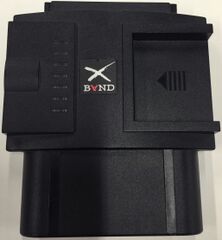XB∀ND
From Sega Retro

| |||||||||||||||
| XB∀ND | |||||||||||||||
|---|---|---|---|---|---|---|---|---|---|---|---|---|---|---|---|
| Made for: Sega Mega Drive | |||||||||||||||
| Manufacturer: Catapult | |||||||||||||||
| Distributor: THQ (US) | |||||||||||||||
| Type: Network tool | |||||||||||||||
|
XB∀ND is the name of a video game modem/online service offered by Catapult in the mid-1990s. It allowed video game consoles to connect to the internet, so players could compete online, as well as check emails (or "xmails" as they were called here) and read news about the service. It also allowed players to chat to each other over the phone line while playing the game.[4] While the Mega Modem was able to connect Mega Drives consoles over phone lines back in 1990, XB∀ND was one of the first of its kind to be released outside of Japan.
As a third party invention, XB∀ND modems were available for several consoles - the Sega Mega Drive (Genesis) in North America and Brazil, and the Super NES, also in North America. The XB∀ND name was not retained across regions of the world. In Brazil the Mega Drive service came in the form of the Mega Net 2 (following the Mega Net, a different service). In Japan, the technology would later be used to power the Sega Saturn Modem - for more information on that XB∀ND service see the aforementioned article.
As with most old online systems, the XB∀ND servers no longer exist, meaning the modems are without purpose.
Contents
System details
All XB∀ND modems plug into the cartridge slot of the console, require their own external power supply and a telephone line to connect to. Similar to the Game Genie and other adaptors, a game cartridge is to be placed on top of the XB∀ND modem in order for the game to function.
The modem comes equipped with a "smart chip" capable of detecting supported games, so no special cartridges or modifications are required. Games which are not recognised will function as normal, meaning the XB∀ND modem can be permanently plugged in.
Once connected, users would arrive at a home page which contained a number of options.
An "auto match" feature would find an opponent to play against instantly - it would instruct Catapult's server to find an opponent of the same skill level as you anywhere in country who wanted to play the same game at the same time. The server then directed one of the two modems to call the other. There are rumours that some games were playable in 2-on-2 matches but this has not been confirmed. The service gave users an icon and game name to maintain privacy.
An email system (called "Xmail") was also available, and every time a user connected, two online newspapers (called "bandwidth") with the latest info were downloaded for you to read. The server also kept track of stats, ranked players, offered game tips and firmware upgrades, and informed users of competitions and updates on other players. After matches, you could "chat" with your opponent, using an interface similar to that used for the email. XB∀ND even had a call-waiting feature.
Catapult implemented a parental control feature which automatically made the unit only able to call locally unless specified otherwise. Parents could also control just how long their kids would play on the network. These controls could be updated at any time.
For such an early attempt at online gaming, the system was surprisingly stable. According to Catapult:
XB∀ND communication latency is low enough (<50 milliseconds) that the response delay in even a coast-to-coast video game is barely perceptible by an expert human game player (New York to Los Angeles latency is about 35 milliseconds through copper or fiber optics). For comparison, Internet latency ranges from 200 milliseconds to more than one second, so Internet games such as NetTrek need to allow for arbitrary delays. Online services connect through x.25 packet-data networks that have latencies between 250 milli-seconds and 1.5 seconds.
History
United States
Similar to the Sega Channel, the XB∀ND service saw the bulk of its success in the United States. It was launched on November 17, 1994[2][1].
$4.95 got you fifty connections (the amount of times the network connected you to an opponent) a month, while $9.95 gave you unlimited local connections, with the first month of play free. For $3.95 an hour, you could play long distance anywhere in the continental United States.
The service was initially a smash success in its five-city test run (San Francisco, Dallas, Atlanta, New York, and Los Angeles)[1]. Catapult intended to capitalize on this momentum and announced on August 10, 1995, that it was teaming up with Blockbuster Video to expand their XB∀ND sell-through program. It was one of the most successful national rollouts in Blockbuster history, increasing the number of retailers selling XB∀NDs to 4500. Blockbuster employees were trained in the use of the service and its features, while four feet of display space with headers and four shelves of space were allotted for the product - not too shabby for a concept most people considered to be unfeasible on consoles. Additionally, Catapult created a two-minute video about the service that could be rented from Blockbuster for free.
At its height, the US service boasted that gamers spent 20 hours a month online, playing about a million games and sending or receiving around 80 messages.
Reaching its peak in mid-1995, the service saw its user base begin to taper off by the middle of the next year. Catapult eventually discontinued the XB∀ND and the servers were shut down on April 30, 1997. A lack of new interest in the service, as well as the demise of 16-bit systems were cited as the reasons behind the XB∀ND's failure. It is most likely though, that what ended its run is ironically the very thing it tried to bring to gamers in the first place: the internet. Online PC gaming exploded in the late '90s, offering gamers many more options of play and a multitude of titles not even remotely possible on the XB∀ND. Even with the power offered by the next generation of consoles, it was simply not enough.
List of compatible games
In addition, Sega's NFL 95 was at one point set to be given XB∀ND support[1] but the feature never materialised.
Brazil
In Brazil, the XB∀ND modem was released for the Mega Drive as the "Mega Net 2", though was identical to the US offering, bar menu translations into Portuguese. The service was free of cost for the first month; later the users could choose between paying R$6.99 for 30 connections per month or R$9.99 for unlimited use.
It was initially released only in the region of São Paulo capital city in October 1996, while Rio de Janeiro, Belo Horizonte, Porto Alegre, Fortaleza and Brasília would start to see it from November on. It is currently unknown if the service was made available countrywide. The service remained available until mid-1998.[5]
The "Mega Net 2" is a significantly rarer peripheral for the console and thus has not been documented fully.
List of compatible games
- FIFA Soccer '95
- Mortal Kombat II
- Mortal Kombat 3
- NBA Jam
- Super Street Fighter II: The New Challengers
Issues
Droppers*
In beta testing, the bottom-feeding scum known as "droppers" reared their ugly heads. At first, sore losers would simply hit the reset button on their consoles to save themselves from gaining a loss to their stats. This would make the game freeze, causing the system to realize the connection had been lost and then restart. When the dropper and his opponent reconnected, the service would offer its best guess as to what went wrong.
Those who hit reset were very comfy at the beginning of the service. The network essentially downloaded a patch to the unit to make each game playable online and early ones were sometimes unstable. This caused games to occasionally lock up, making it necessary to reset the system. Though later patches were more stable and attempts were made to identify abuse, it was impossible to catch every dropper. Most games, however, were successful in avoiding this abuse by automatically penalizing the dropper with a loss and giving a win to their opponent. This depended on the last scores sent to the server by the unit before the connection was cut.
Droppers were quite sneaky, using one of three despicable methods to save their precious stats. They could simply call themselves (if you had call waiting), hit reset, or simply disconnect the phone cord from the unit itself. Unfortunately for those with call waiting, the service detected this and either restarted the game completely over or from the beginning of the last period played (e.g. the end of the previous quarter in Madden or NBA Jam). Some droppers called themselves over and over, causing their opponent to either be outscored or to just quit in frustration. If they were behind when they quit, they would get the loss and would receive nothing if they were winning.
Once the option to reset the console was no longer available, droppers tried their last option: disconnecting the phone cord. Once they reconnected, the reset detector sent them an email detailing what happened and how it affected their stats. This lead to a deluge of customer service calls offering all kinds of excuses as to why the cord had been disconnected. Not even attempts to monitor power levels on the telephone line were effective in combating this, however, so opponents were awarded wins to keep them happy while droppers were not penalized in order to keep them from complaining. This hurt the service in the long run by scaring off potentially honest gamers, much the same way current droppers have scared off many players from games like Capcom vs. SNK 2 on Xbox Live.
Artwork
Magazine articles
- Main article: XB∀ND/Magazine articles.
Promotional material
also published in:
- (US) #64: "November 1994" (1994-xx-xx)[6]
also published in:
- (US) #23: "February/March 1995" (199x-xx-xx)[7]
Gallery
Physical scans
External links
- Mega Net 2 official website (Portuguese) (archive)
References
- ↑ 1.0 1.1 1.2 1.3 1.4 Press release: 1994-11-08: XBAND Video Game Network on-line Nov. 17 with multimillion-dollar marketing campaign; Nov. 25 coast-to-coast event with Electronic Arts/EA SPORTS
- ↑ 2.0 2.1 EGM², "December 1994" (US; 1994-1x-xx), page 42
- ↑ 3.0 3.1 http://www.tectoy.com.br/releases/index.htm (Wayback Machine: 1998-06-25 19:48)
- ↑ Computer & Video Games, "March 1994" (UK; 1994-02-15), page 7
- ↑ http://comunidademegadrive.wordpress.com/2011/04/30/o-mega-drive-tambem-se-conecta-com-a-internet/ (Wayback Machine: 2011-05-10 01:09)
- ↑ GamePro, "November 1994" (US; 1994-xx-xx), page 217
- ↑ Sega Visions, "February/March 1995" (US; 199x-xx-xx), page 42
- ↑ Next Generation, "April 1995" (US; 1995-03-21), page 6
- ↑ GamePro, "April 1995" (US; 1995-xx-xx), page 128
- ↑ Next Generation, "May 1995" (US; 1995-04-18), page 22
- ↑ Electronic Gaming Monthly, "May 1995" (US; 1995-0x-xx), page 40










